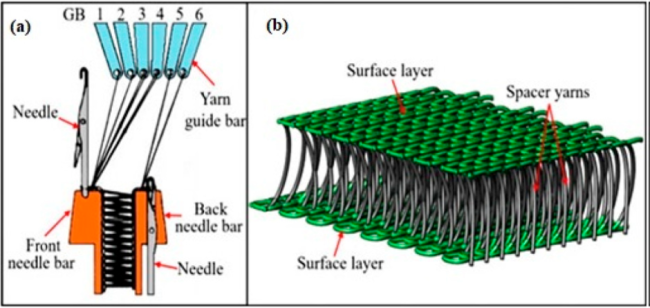Introduction to Spacer Fabrics
Spacer fabrics represent an advanced and evolving field within textile technology, focusing on the development of three-dimensional woven and knitted materials. These fabrics extend their applicability to functional and technical clothing by offering multifunctional properties. With growing competition in the textile industry, manufacturers are increasingly prioritizing innovation to create products that outperform traditional fabrics in terms of both performance and aesthetics.
Advancements in 3D Textiles
Recent advancements in 3D textiles have paved the way for novel fabrics with diverse applications. One of the key benefits of 3D textiles is their ability to reduce material consumption, maintain a consistent yarn architecture, and streamline production. However, this comes at the cost of productivity, with a decrease of 5-10 times compared to standard 2D fabrics. Increased machine investment and process costs are necessary to accommodate the complex parts and demanding machinery used to manufacture 3D textiles.
Despite these challenges, significant efforts have been made to develop new varieties of 3D fabrics for technical applications. One such innovation is 3D spacer fabrics, which are created through modifications in both the machinery and manufacturing techniques. These fabrics offer a range of unique properties, including low area densities, customizable thicknesses, superior comfort, and enhanced permeability, without the need for additional materials such as foam, rubber, or latex.
Types of Spacer Fabrics
Spacer fabrics can be categorized into woven, nonwoven, braided, and knitted types, with woven and knitted variants being the most prominent in technical textiles. Woven spacer fabrics consist of two outer layers formed using two independent warp systems, with a third warp system passing through to create the 3D structure. These fabrics have applications in filtration, cushioning, inflatables, and heat dissipation.
Knitted spacer fabrics, on the other hand, are widely used in engineering applications due to their efficient processing. These fabrics are produced on machines such as flat knitting machines, raschel knitting machines, and circular double jersey machines. The structure of weft-knitted spacer fabrics consists of two separate knitted layers joined by a connective yarn. Depending on the yarn types and structural variations, spacer fabrics can exhibit properties that are unmatched by conventional textiles.
Technical and Functional Applications
Spacer fabrics have found applications in various technical fields, including protective clothing, transportation, geo-textiles, building materials, military equipment, medicine, and sports. In these sectors, the fabrics’ unique properties—such as elasticity, insulation, and shock absorption—offer significant advantages over traditional textiles. The open structure of these fabrics also provides breathability and acoustic damping, making them suitable for high-performance applications.
Production Technologies
- Weft Knitted Spacer Fabrics (WeKSFs): These fabrics can be created on circular dial and cylinder machines using a combination of stitch techniques. Special feeders and Jacquard patterning can be incorporated to create intricate designs. The production process on circular knitting machines, however, faces limitations due to the geometry of the yarn feeding path.
- Flat Knitting Machine: This machine offers high flexibility for producing 3D textiles, including spacer fabrics, by varying the stitch length and pattern. Techniques such as widening, narrowing, and bind-off allow for the creation of complex shapes. The flat knitting technique can also produce reinforced spacer fabrics by integrating functional or conductive yarns like carbon filaments or copper wires.
- Warp Knitted Spacer Fabrics (WKSFs): These fabrics are typically created using raschel machines, which consist of two fabric layers joined by spacer yarns. Adjustments in guide bar threading and lapping allow for precise control of fabric stability and permeability. WKSFs are commonly used in applications such as seating, automotive interiors, mattresses, and orthopedic products.
Innovative Spacer Fabrics
Innovative structures in spacer fabrics are achieved using computerised flat-knitting techniques that allow for the production of 3D spacer fabrics without reinforcements. Curvilinear shapes and tubular structures can be created using advanced integration concepts and specialized machines. These innovative fabrics are increasingly used in niche applications such as artificial tracheal stents, fibre-reinforced plastics, and other technical textiles that require high durability and performance.
Future Prospects
As the textile industry continues to evolve, spacer fabrics are expected to play a significant role in new product development. Their aesthetic, functional, and technical advantages make them ideal for niche applications in industries where traditional textiles are no longer sufficient. Advances in 3D knitting and weaving technologies will likely expand the range of possibilities for spacer fabrics, enabling the creation of complex, high-performance textiles that meet the demands of modern technical applications.
Conclusion
The innovative development of spacer fabrics has opened up new possibilities in both functional and technical textiles. By leveraging the latest advancements in 3D weaving and knitting technologies, manufacturers are able to create fabrics that offer superior properties compared to traditional textiles. As these fabrics continue to evolve, they will undoubtedly find new applications in a wide range of industries, further establishing spacer fabrics as a key component of modern textile innovation.
